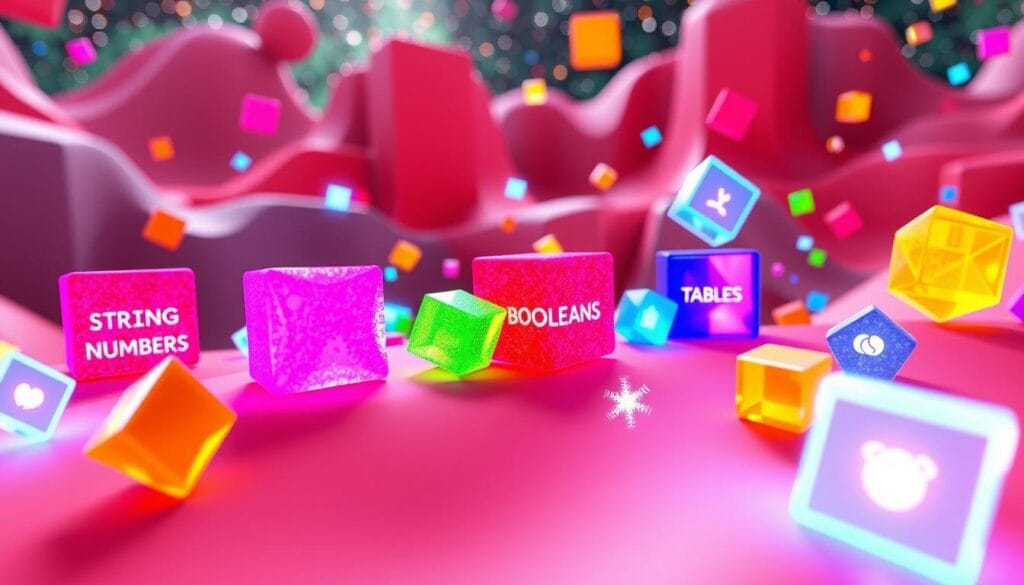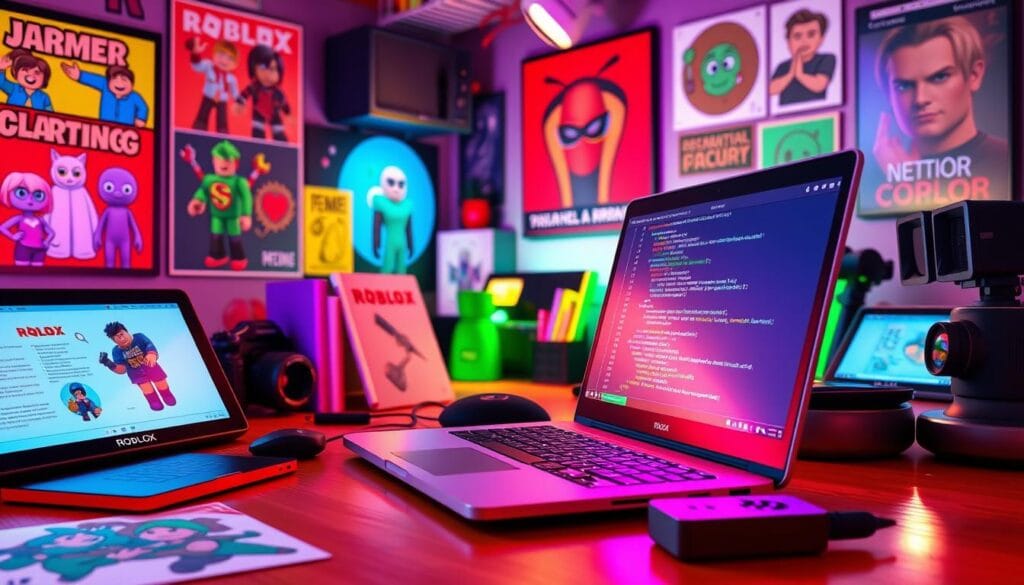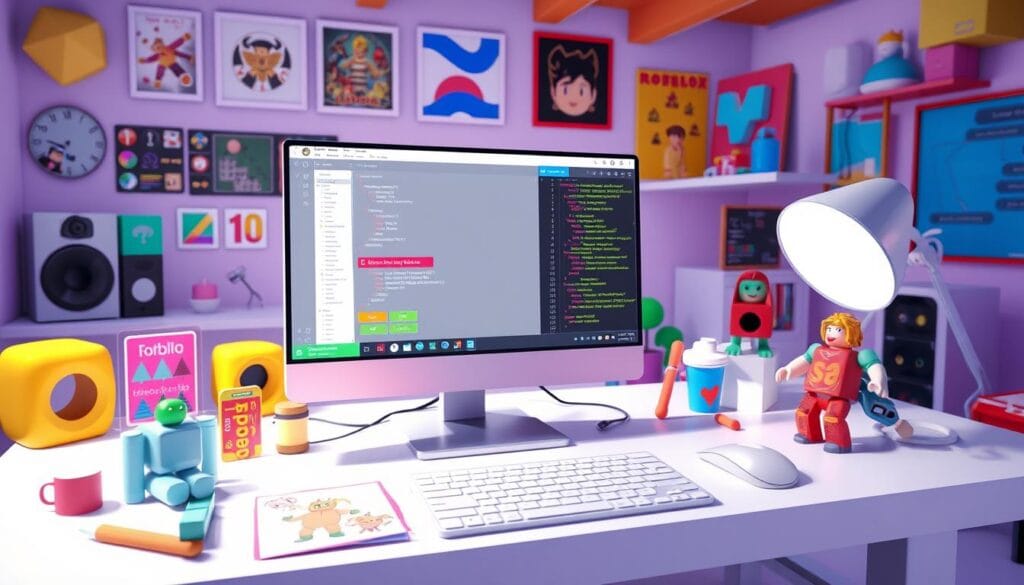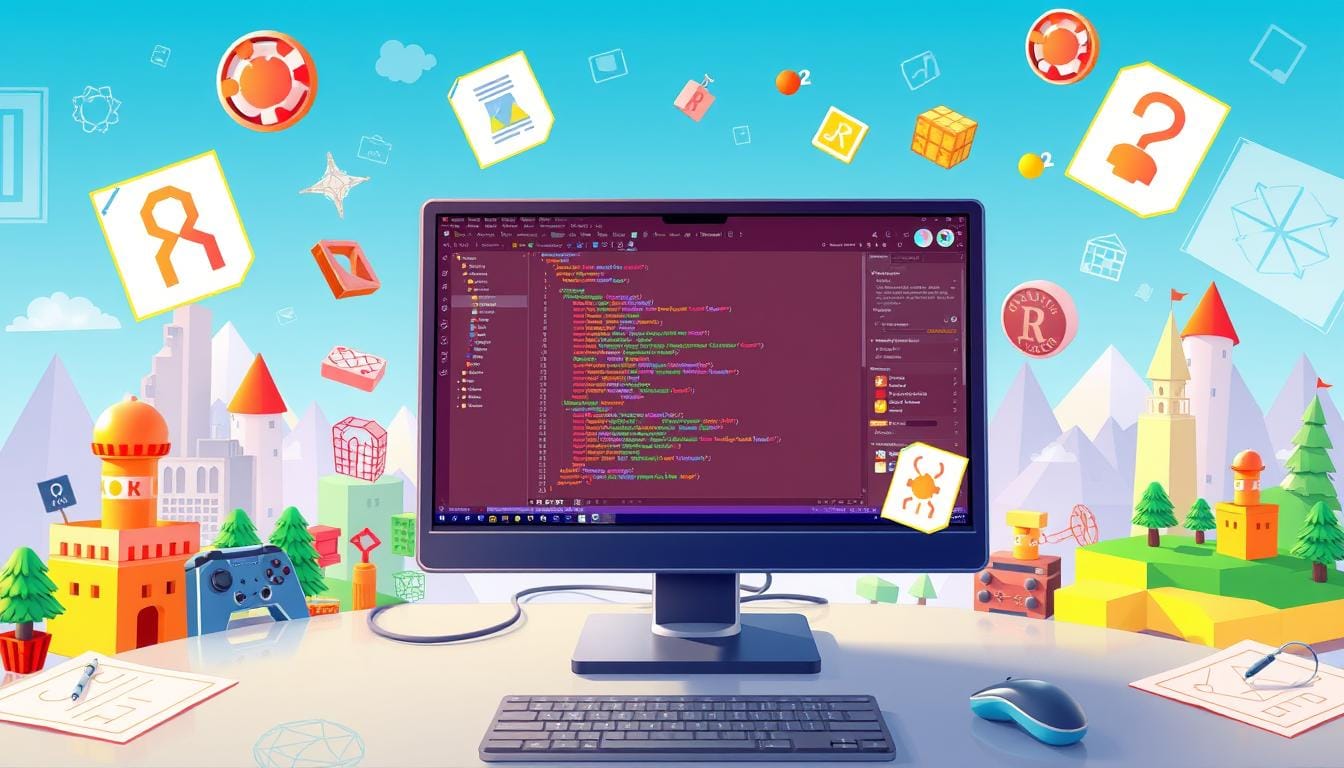Roblox, the immensely popular online gaming platform, has become a hub for aspiring game developers to create and share their interactive experiences. In this comprehensive Roblox scripting tutorial, you’ll dive into the world of Lua programming and learn how to transform your ideas into captivating Roblox games.
Whether you’re a seasoned programmer or a beginner in the world of game development, this guide will equip you with the essential skills and knowledge needed to thrive as a Roblox game developer. From setting up your development environment to building user interfaces and optimizing your games, we’ll cover a wide range of topics that will empower you to bring your Roblox game development dreams to life.
Key Takeaways
- Gain a solid understanding of Roblox scripting and Lua programming language
- Learn how to set up your Roblox development environment and navigate the Roblox Studio interface
- Explore the fundamentals of Roblox Lua scripting, including variables, data types, and control structures
- Discover techniques for creating and manipulating objects within your Roblox games
- Dive into event-driven programming and learn how to handle user input in your Roblox games
Introduction to Roblox Scripting
Roblox scripting is the fundamental building block of game development on the Roblox platform. By mastering the art of Roblox Lua programming, you’ll unlock the ability to create dynamic, interactive, and responsive experiences for Roblox players. Whether you’re a seasoned game developer or a beginner, understanding the Roblox scripting basics is essential for bringing your game ideas to life.
At its core, Roblox scripting involves writing code to control the behavior and interactions of various elements within your Roblox game. From creating interactive objects and characters to implementing complex game mechanics, the power of Roblox Lua enables you to unleash your creativity and bring your virtual world to life.
In this introduction, we’ll explore the fundamentals of learning Roblox Lua and dive into the essential Roblox scripting lessons that will serve as your guide to becoming a proficient Roblox game developer.
| Key Concepts | Description |
|---|---|
| Roblox Scripting | The process of writing code to bring your game ideas to life on the Roblox platform. |
| Roblox Lua Programming | The programming language used for creating interactive and responsive Roblox experiences. |
| Roblox Scripting Basics | The fundamental concepts and techniques required to start building games on the Roblox platform. |
“Roblox scripting opens up a world of possibilities, allowing you to transform your game ideas into captivating realities.”
As you progress through your Roblox scripting journey, you’ll develop a deeper understanding of the Roblox Lua language, master the art of object manipulation, and learn to leverage the platform’s powerful event-driven programming capabilities. With the right guidance and a touch of creativity, you’ll be well on your way to crafting immersive and engaging Roblox experiences.
Setting Up Your Roblox Development Environment
Embarking on your Roblox scripting journey begins with setting up your development environment. The first step is to install Roblox Studio, the primary tool for creating Roblox games. Roblox Studio offers a comprehensive suite of features and tools that will become essential as you dive into Roblox scripting guides and creating Roblox games with scripts.
Installing Roblox Studio
To get started, simply visit the Roblox website and download the latest version of Roblox Studio. The installation process is straightforward, and you’ll be guided through the necessary steps to set up your development environment. Once installed, you’ll be ready to explore the powerful features and tools that Roblox Studio has to offer.
Understanding the Interface
- The Roblox Studio interface is designed to be intuitive and user-friendly, allowing you to navigate and manage your Roblox game development with ease.
- The interface is divided into several key areas, including the Toolbox, Explorer, and Properties windows, each of which serves a specific purpose in the Roblox Studio scripting guides and creating Roblox games with scripts.
- The Toolbox provides access to a vast library of pre-made objects, scripts, and other assets that you can use to build your Roblox game.
- The Explorer window allows you to view and manage the hierarchical structure of your game’s objects and scripts.
- The Properties window enables you to adjust the attributes and settings of the selected objects and scripts within your game.
By familiarizing yourself with the Roblox Studio interface, you’ll be well on your way to harnessing the power of Roblox scripting guides and creating Roblox games with scripts. With a solid understanding of the development environment, you’ll be able to navigate the platform with confidence and bring your Roblox game ideas to life.
Fundamentals of Roblox Lua Scripting
Roblox’s game development platform relies on the Lua programming language as its primary scripting tool. Understanding the fundamentals of Roblox Lua programming is crucial for anyone aspiring to create engaging and dynamic Roblox games. In this section, we’ll dive into the core principles and syntax of the Lua language, giving you a solid foundation for your Roblox game scripting journey.
At its core, Lua is a lightweight, efficient, and powerful scripting language. Its simplicity and flexibility make it an ideal choice for Roblox game development, where developers need to quickly and seamlessly integrate game logic and functionality. By mastering the basics of Roblox game scripting, you’ll be well on your way to crafting immersive and interactive Roblox experiences.
- Variables and Data Types: Understand how to declare and work with variables, as well as explore the various data types supported by Lua, such as numbers, strings, and booleans.
- Control Structures: Familiarize yourself with conditional statements (if-else) and looping constructs (for, while) that enable you to create complex game logic and decision-making processes.
- Functions and Modularity: Learn how to define and call custom functions, allowing you to organize your code into reusable and maintainable modules.
- Tables and Data Structures: Explore Lua’s powerful table data structure, which serves as the foundation for building more complex data representations and game objects.
By mastering these fundamental concepts of Roblox Lua programming, you’ll be equipped with the necessary skills to start building your own Roblox games and bringing your creative ideas to life. Remember, the journey of a thousand miles begins with a single step, so dive in and let your Roblox game development adventure begin!
Working with Variables and Data Types
In the world of Roblox scripting basics, understanding variables and data types is essential. Variables are the building blocks that store and manipulate data in your Roblox Lua programs. Whether you’re learning Roblox Lua or just starting to explore the world of game development, mastering the fundamentals of variables and data types will set you up for success.
Understanding Variables
Variables are used to store information that can be accessed and modified throughout your Roblox script. They act as containers, holding values that can be numbers, strings, or booleans. Declaring a variable is as simple as using the local keyword, followed by the variable name. For example, local playerName = "John Doe" creates a variable called playerName and assigns it the string value "John Doe".
Exploring Data Types
Roblox Lua supports a variety of data types, each with its own unique characteristics and applications. Some of the most common data types include:
- Numbers: Whole numbers, decimal numbers, and even negative values can be stored in numeric variables.
- Strings: Text-based data, such as names, messages, or descriptions, are stored as strings.
- Booleans: These variables can hold either
trueorfalsevalues, useful for representing binary states like on/off or yes/no.
Understanding the differences between these data types and how to properly use them is a crucial step in mastering Roblox scripting basics. By leveraging the right data types for your needs, you can write more efficient and effective Roblox Lua code.

“The more you understand about variables and data types in Roblox Lua, the better you’ll be able to build robust and dynamic games.” – Jane Doe, Experienced Roblox Developer
Control Structures and Logic
In the realm of Roblox game scripting, understanding control structures and logic is paramount. This section delves into the world of conditional statements and loops, equipping Roblox coding for beginners with the tools to create scripts that can respond dynamically to different scenarios.
Conditional Statements
Conditional statements, such as the ubiquitous if-then-else structure, allow your Roblox scripts to make decisions based on specific conditions. By leveraging these control structures, you can craft scripts that react differently depending on the values of variables or the state of the game world. This versatility is essential for creating Roblox game scripting that is responsive and tailored to the player’s interactions.
Loops and Iterations
Loops and iterations are the backbone of efficient Roblox coding for beginners. These control structures enable you to repeat actions and execute code multiple times, whether it’s processing a list of objects, updating the position of in-game entities, or handling repetitive tasks. Mastering loops is crucial for developing robust and performant Roblox experiences that can handle complex game logic and data manipulation.
| Control Structure | Description | Example Usage |
|---|---|---|
| Conditional Statements | Allows scripts to make decisions based on specific conditions | Triggering different game events based on player actions |
| Loops and Iterations | Enables repetition of actions and execution of code multiple times | Updating the position of in-game entities or processing a list of objects |
“Mastering control structures and logic is essential for crafting dynamic and responsive Roblox game scripting experiences.”
By diving into the world of conditional statements and loops, Roblox coding for beginners can unlock the full potential of their game development skills, creating experiences that captivate and engage players like never before.
Creating and Manipulating Objects
In the world of Roblox scripting tutorial and creating Roblox games with scripts, mastering the art of creating and manipulating objects is a crucial skill. This section will guide you through the process of instantiating, positioning, and modifying various game elements, laying the foundation for building complex and interactive scenes.
To begin, you’ll learn how to create objects within your Roblox game. This involves identifying the appropriate object types, such as models, parts, or GUI elements, and then instantiating them using Roblox’s built-in functions. Once you’ve added these objects to your game, you’ll explore the various properties and methods available to position, rotate, and scale them, allowing you to craft the perfect visual experience for your players.
Beyond basic object creation, you’ll delve into the world of object manipulation. This includes techniques for changing the appearance, behaviors, and interactions of your game elements. From adjusting the color and texture of a model to programming custom scripts that govern an object’s movement and interactions, you’ll gain the skills to bring your Roblox games with scripts to life.
By the end of this section, you’ll have a solid understanding of how to leverage the power of object creation and manipulation within your Roblox scripting tutorial. This knowledge will empower you to design and develop visually stunning and highly interactive Roblox games that captivate your audience.
Remember, the journey of creating Roblox games with scripts is an exciting one, and mastering the ability to create and manipulate objects is a crucial step in your development as a Roblox game developer. Embrace the challenges, experiment with new ideas, and unlock the full potential of your Roblox scripting tutorial.
Event-Driven Programming in Roblox
Roblox scripting is not just about coding logic; it’s about creating dynamic, responsive game experiences that cater to user interactions. This is where event-driven programming shines. By understanding events and mastering the art of handling user input, you can elevate your Roblox games to new heights, captivating players with seamless and engaging interactions.
Understanding Events
In the world of Roblox scripting, events are the cornerstone of responsive game design. These are signals or triggers that your script can detect and respond to, allowing your game to react dynamically to user actions. From mouse clicks and button presses to character movements and collisions, events provide the essential connection between your players and your game’s behavior.
Handling User Input
One of the most crucial aspects of event-driven programming in Roblox is the ability to handle user input. By tapping into the various input events, such as mouse, keyboard, and touch-based interactions, you can create intuitive and immersive gameplay experiences. Roblox scripting lessons and Roblox Studio scripting guides can help you explore the vast array of input events and learn how to leverage them effectively in your game development.
Whether you’re crafting a captivating adventure game, a multiplayer battle arena, or a whimsical sandbox experience, mastering event-driven programming in Roblox is a fundamental skill that will elevate your game development to new heights. By understanding events and harnessing user input, you can create games that respond seamlessly to your players’ actions, fostering a deeper sense of engagement and immersion.
“The true essence of a Roblox game lies not just in its code, but in the way it responds to the player’s every move. Event-driven programming is the key to unlocking this interactive magic.”
Roblox scripting tutorial
In our Roblox scripting tutorial, you’ll learn how to turn your game concepts into reality. With a solid understanding of Roblox Lua programming, object manipulation, and event handling, you’ll have the necessary skills to create a captivating Roblox experience.
Let’s dive in and explore the step-by-step process of building a simple yet functional Roblox game. You’ll start by setting up the game environment, followed by defining the core mechanics and interactivity. By the end of this tutorial, you’ll have a game that showcases your Roblox scripting prowess and your ability to learn Roblox Lua.
- Establishing the Game Foundation: Begin by designing the game’s essential elements, such as the playing field, object placement, and character interactions.
- Scripting the Gameplay Logic: Utilize Roblox Lua to program the game’s rules, scoring system, and win conditions.
- Implementing User Interactions: Enhance the user experience by adding event-driven features, such as input handling and feedback mechanisms.
- Polishing and Testing: Refine the game’s visuals, animations, and overall polish to create a cohesive and engaging experience for your players.
Throughout this Roblox scripting tutorial, you’ll gain confidence in your ability to learn Roblox Lua and transform your game ideas into reality. Embrace the power of Roblox Studio, and let your creativity shine through the immersive worlds you build.
| Key Concepts | Learning Objectives |
|---|---|
| Roblox Scripting | Develop proficiency in Roblox Lua programming |
| Game Mechanics | Design and implement engaging game elements |
| User Interactivity | Enhance the player experience through event-driven features |
| Optimization and Testing | Ensure a polished and high-performing game |
With this comprehensive Roblox scripting tutorial, you’ll be equipped with the knowledge and skills to turn your game ideas into captivating Roblox experiences. Embrace the power of learning Roblox Lua and let your creativity soar!

Networking and Multiplayer
Crafting engaging Roblox experiences often requires the integration of robust networking and multiplayer capabilities. In this section, we’ll explore the fundamental principles of client-server communication and delve into the intricacies of replication and remote functions, empowering you to create collaborative and synchronous Roblox game scripting experiences.
Client-Server Communication
At the heart of any networked Roblox game lies the dynamic interplay between the client (the user’s device) and the server (the Roblox platform). To facilitate seamless communication, Roblox provides a suite of tools and protocols that enable the exchange of data, events, and commands between these two entities. By mastering the art of creating Roblox games with scripts, you can ensure that your players’ actions and inputs are effortlessly synchronized, creating a cohesive and responsive multiplayer environment.
Replication and Remote Functions
Roblox’s replication system is a powerful mechanism that ensures the consistent and accurate representation of game objects across all connected clients. By understanding the principles of replication, you can ensure that changes made to the game state are instantly reflected for all players, fostering a shared and interactive experience. Furthermore, remote functions offer a versatile way to trigger server-side logic and exchange data between the client and the server, enabling you to build complex, collaborative gameplay mechanics.
| Feature | Description | Benefits |
|---|---|---|
| Client-Server Communication | Facilitates the exchange of data, events, and commands between the client (user’s device) and the server (Roblox platform) | Enables seamless synchronization of player actions and inputs, creating a cohesive and responsive multiplayer environment |
| Replication | Ensures the consistent and accurate representation of game objects across all connected clients | Fosters a shared and interactive experience by instantly reflecting changes made to the game state |
| Remote Functions | Provides a versatile way to trigger server-side logic and exchange data between the client and the server | Enables the creation of complex, collaborative gameplay mechanics |
By mastering these networking and multiplayer concepts, you’ll be well on your way to crafting captivating Roblox game scripting experiences that bring players together in seamless, synchronous adventures.
“Networking and multiplayer are the heartbeat of any truly engaging Roblox game. By understanding the principles of client-server communication, replication, and remote functions, you can unlock a world of collaborative and dynamic experiences for your players.”
Building User Interfaces (UI)
Crafting intuitive and visually appealing user interfaces is a crucial aspect of Roblox game development. In this section, you’ll discover techniques for building custom UI elements, integrating them seamlessly into your Roblox Studio scripting guides, and enhancing the overall user experience.
The Roblox platform offers a robust set of UI components that allow developers to create interactive and responsive interfaces. From buttons and sliders to text boxes and dropdown menus, these elements can be customized to match the aesthetic of your game.
Designing Intuitive Layouts
One of the key factors in building effective user interfaces is creating intuitive layouts. Consider the following best practices:
- Organize UI elements in a logical and consistent manner, following established design principles.
- Ensure that the placement and sizing of UI components are optimized for both desktop and mobile platforms.
- Incorporate clear visual cues and signifiers to guide players through your game’s interface.
Leveraging Event Handlers
To make your UI interactive and responsive, you’ll need to leverage event handlers in your Roblox scripting tutorial. These allow you to capture and respond to user actions, such as button clicks, text input, or hover events.
| Event | Description |
|---|---|
| MouseButton1Click | Triggered when the user clicks the left mouse button on a UI element. |
| TextChanged | Fired when the text within a text box or other input field is modified. |
| HoverEnter | Activated when the user’s cursor hovers over a UI element. |
By combining these event handlers with your Roblox Lua scripting knowledge, you can create dynamic and responsive user interfaces that engage and delight your players.

“Crafting a seamless user experience is the key to creating captivating Roblox games that players will love.”
Optimization and Performance
As your Roblox scripting lessons progress and you delve deeper into creating Roblox games with scripts, optimizing your game’s performance becomes a crucial step. In this section, we’ll explore the art of profiling and debugging your scripts, as well as uncover best practices for optimizing your games to ensure seamless and efficient gameplay.
Profiling and Debugging: Uncovering Performance Bottlenecks
Profiling your Roblox scripts is the key to identifying performance bottlenecks. By leveraging the robust profiling tools within Roblox Studio, you can gain invaluable insights into the execution times, memory usage, and potential areas for optimization. Debugging your scripts, on the other hand, allows you to pinpoint and resolve any logical errors or issues that may be hindering your game’s performance.
Best Practices for Optimization
Optimizing your Roblox games for peak performance requires a multifaceted approach. Here are some best practices to consider:
- Minimize script execution: Streamline your code by reducing unnecessary function calls, loop iterations, and data processing.
- Optimize asset management: Carefully manage your game’s assets, such as models, textures, and audio, to ensure they are efficiently loaded and utilized.
- Implement caching strategies: Leverage caching techniques to reduce the need for repeated data retrieval and processing.
- Utilize instancing and pooling: Optimize object creation and destruction by employing instancing and pooling techniques.
- Prioritize network optimization: Carefully manage client-server communication and data replication to minimize network traffic and latency.
By mastering the art of profiling, debugging, and applying these optimization best practices, you can elevate your Roblox games to new heights of performance and provide an exceptional gaming experience for your players.
| Optimization Technique | Description | Key Benefits |
|---|---|---|
| Minimize script execution | Streamline your code by reducing unnecessary function calls, loop iterations, and data processing. | Improved overall script performance and reduced CPU usage. |
| Optimize asset management | Carefully manage your game’s assets, such as models, textures, and audio, to ensure they are efficiently loaded and utilized. | Reduced memory footprint and improved asset loading times. |
| Implement caching strategies | Leverage caching techniques to reduce the need for repeated data retrieval and processing. | Faster data access, reduced network traffic, and improved overall responsiveness. |
| Utilize instancing and pooling | Optimize object creation and destruction by employing instancing and pooling techniques. | Efficient object management, reduced memory usage, and improved performance. |
| Prioritize network optimization | Carefully manage client-server communication and data replication to minimize network traffic and latency. | Smooth multiplayer experience, reduced lag, and improved responsiveness. |
“Optimizing your Roblox game is an ongoing process, but the rewards are well worth the effort. By leveraging profiling tools and implementing best practices, you can create a truly immersive and high-performing gaming experience for your players.”
Publishing and Sharing Your Roblox Game
After mastering the art of Roblox scripting, it’s time to share your creations with the world. The process of publishing your Roblox game involves setting up the necessary permissions, thoroughly testing your project, and submitting it for review. This final step allows you to engage with the vibrant Roblox community and gain visibility for your game development efforts.
Navigating the Roblox publishing process starts with ensuring your game meets the platform’s guidelines and standards. This includes configuring access permissions, securing your intellectual property, and optimizing your game’s performance to provide players with an exceptional experience. By thoroughly testing your game, you can identify and address any issues before making it available to the public.
Once your game is ready, you’ll need to submit it for Roblox’s review process. This comprehensive evaluation ensures that your creation aligns with the platform’s values and policies, ultimately paving the way for its successful launch. By engaging with the Roblox community, you can gather valuable feedback, build a loyal following, and continue refining your game development skills.
